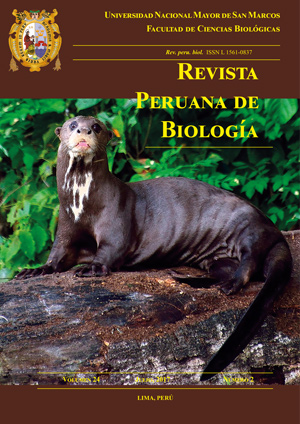Giant Otter (Pteronura brasiliensis) distribution and population status in Madre de Dios River basin, southeastern Peru
DOI:
https://doi.org/10.15381/rpb.v24i2.13493Keywords:
Madre de Dios, conservation, Amazonia, Alluvial mining, endangered species, apex predator, Population stronghold.Abstract
Population status and geographic distribution of the giant otter (Pteronura brasiliensis) from Madre de Dios Region (south-eastern Peru) of 2014 and 2015 periods are presented. Population census for each period were 128 individuals, grouped in 22 and 20 resident groups during 2014 and 2015 periods respectively. The Manu National Park (2.2 ind/10 km) and Bahuaja Sonene National Park (1.43 ind/10 km.) were the sectors with the greatest abundance of giant otters inside the natural protected areas (ANP), while, Las Piedras and Los Amigos rivers were the sectors, outside the ANP, with highest value of abundance: 0.5 and 0.43 ind/10 km respectively. The populations inside ANP show more stable and protected (17 resident groups), while outside ANP are more vulnerable, where we registered only five (2014) and two (2015) giant otter groups. Currently, the main threats for giant other populations from Madre de Dios and the cause of the environmental degradation of its habitats are the gold mining, agriculture and logging. This situation suggests the urgent need to establish a conservation program throughout the region, especially outside ANP.Downloads
Downloads
Published
Issue
Section
License
Copyright (c) 2017 Joel Alexander Mendoza, Keyly Huamani, Germán Sebastián, José Antonio Ochoa

This work is licensed under a Creative Commons Attribution-NonCommercial-ShareAlike 4.0 International License.
AUTHORS RETAIN THEIR RIGHTS:
a. Authors retain their trade mark rights and patent, and also on any process or procedure described in the article.
b. Authors retain their right to share, copy, distribute, perform and publicly communicate their article (eg, to place their article in an institutional repository or publish it in a book), with an acknowledgment of its initial publication in the Revista Peruana de Biologia.
c. Authors retain theirs right to make a subsequent publication of their work, to use the article or any part thereof (eg a compilation of his papers, lecture notes, thesis, or a book), always indicating its initial publication in the Revista Peruana de Biologia (the originator of the work, journal, volume, number and date).






